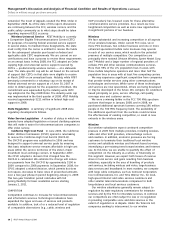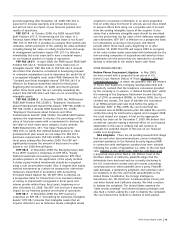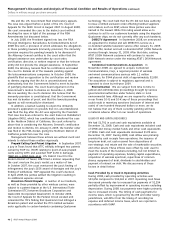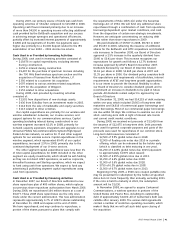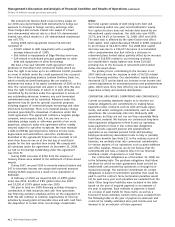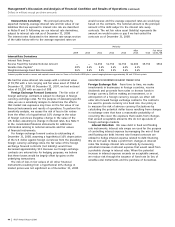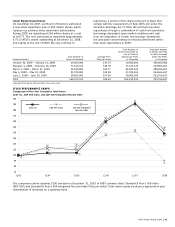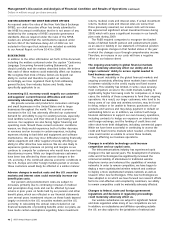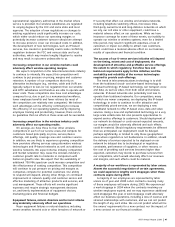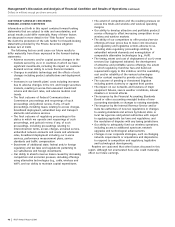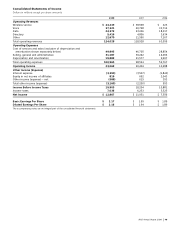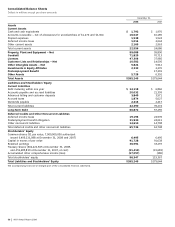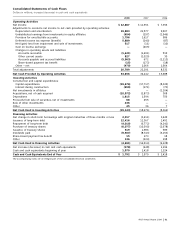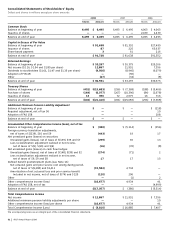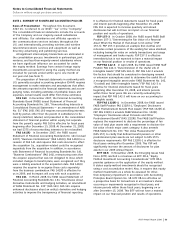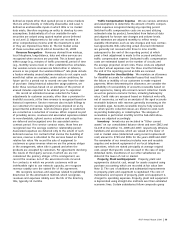AT&T Wireless 2008 Annual Report Download - page 48
Download and view the complete annual report
Please find page 48 of the 2008 AT&T Wireless annual report below. You can navigate through the pages in the report by either clicking on the pages listed below, or by using the keyword search tool below to find specific information within the annual report.
46
| AT&T Annual Report 2008
Management’s Discussion and Analysis of Financial Condition and Results of Operations (continued)
Dollars in millions except per share amounts
CERT I FICAT I O N BY THE CHIEF EXECUT I V E O F FICER
As required under the rules of the New York Stock Exchange
(NYSE), our chief executive officer has timely submitted to
the NYSE his annual certification that he is not aware of any
violation by the company of NYSE corporate governance
standards. Also as required under the rules of the NYSE,
readers are advised that the certifications required under
Section 302 of the Sarbanes-Oxley Act of 2002 are not
included in this report but instead are included as exhibits
to our Annual Report on Form 10-K for 2008.
RISK FACTORS
In addition to the other information set forth in this document,
including the matters contained under the caption “Cautionary
Language Concerning Forward-Looking Statements,” you
should carefully read the matters described below. We believe
that each of these matters could materially affect our business.
We recognize that most of these factors are beyond our
ability to control and therefore to predict an outcome.
Accordingly, we have organized them by first addressing
general factors, then industry factors and, finally, items
specifically applicable to us.
A worsening U.S. economy would magnify our customers’
and suppliers’ current financial difficulties and could
materially adversely affect our business.
We provide services and products to consumers and large
and small businesses in the United States and to larger
businesses throughout the world. The current economic
recession in the U.S. has adversely affected our customers’
demand for and ability to pay for existing services, especially
local landline service, and their interest in purchasing new
services. Our suppliers are also facing higher financing and
operating costs. Should these current economic conditions
worsen, we likely would experience both a further decrease
in revenues and an increase in certain expenses, including
expenses relating to bad debt and equipment and software
maintenance. We also may incur difficulties locating financially
stable equipment and other suppliers thereby affecting our
ability to offer attractive new services. We are also likely to
experience greater pressure on pricing and margins as we
continue to compete for customers who would have even less
discretionary income. While our largest business customers
have been less affected by these adverse changes in the
U.S. economy, if the continued adverse economic conditions in
the U.S., Europe and other foreign markets persist or worsen,
those customers would likely be affected in a similar manner.
Adverse changes in medical costs and the U.S. securities
markets and interest rates could materially increase our
benefit plan costs.
Our pension and postretirement costs are subject to
increases, primarily due to continuing increases in medical
and prescription drug costs and can be affected by lower
returns in prior years on funds held by our pension and other
benefit plans, which are reflected in our financial statements
over several years. Investment returns on these funds depend
largely on trends in the U.S. securities markets and the U.S.
economy. In calculating the annual costs included on our
financial statements of providing benefits under our plans, we
have made certain assumptions regarding future investment
returns, medical costs and interest rates. If actual investment
returns, medical costs and interest rates are worse than
those previously assumed, our annual costs will increase.
We experienced significant actual investment losses during
2008, which will cause a significant increase in our benefit
plan costs during 2009.
The FASB required companies to recognize the funded
status of defined benefit pension and postretirement plans
as an asset or liability in our statement of financial position
and to recognize changes in that funded status in the year
in which the changes occur through comprehensive income.
Therefore, an increase in our costs will have a negative
effect on our balance sheet.
The ongoing uncertainty in global financial markets
could materially adversely affect our ability and our
larger customers’ ability to access capital needed to
fund business operations.
The recent instability in the global financial markets and
ongoing uncertainty affecting these markets have resulted
in extreme volatility in the credit, equity and fixed income
markets. This volatility has limited, in some cases severely,
most companies’ access to the credit markets, leading to
significantly higher borrowing costs for companies or, in many
cases, the inability of these companies to fund their ongoing
operations. As a result, our larger customers, who tend to be
heavy users of our data and wireless services, may be forced
to delay, reduce or be unable to finance, purchases of our
products and services and may delay payment or default on
outstanding bills to us. In addition, we contract with large
financial institutions to support our own treasury operations,
including contracts to hedge our exposure on interest rates
and foreign exchange, and the funding of credit lines and
other short-term debt obligations, including commercial paper.
While we have been successful in continuing to access the
credit and fixed income markets when needed, a financial
crisis could render us unable to access these markets,
severely affecting our business operations.
Changes in available technology could increase
competition and our capital costs.
The telecommunications industry has experienced rapid
changes in the last several years. The development of wireless,
cable and IP technologies has significantly increased the
commercial viability of alternatives to traditional wireline
telephone service and enhanced the capabilities of wireless
networks. In order to remain competitive, we have begun to
deploy a more sophisticated wireline network and continue
to deploy a more sophisticated wireless network, as well as
research other new technologies. If the new technologies we
have adopted or on which we have focused our research efforts
fail to be cost-effective and accepted by customers, our ability
to remain competitive could be materially adversely affected.
Changes to federal, state and foreign government
regulations and decisions in regulatory proceedings
could materially adversely affect us.
Our wireline subsidiaries are subject to significant federal
and state regulation while many of our competitors are not.
In addition, our subsidiaries and affiliates operating outside
the U.S. are also subject to the jurisdiction of national and


